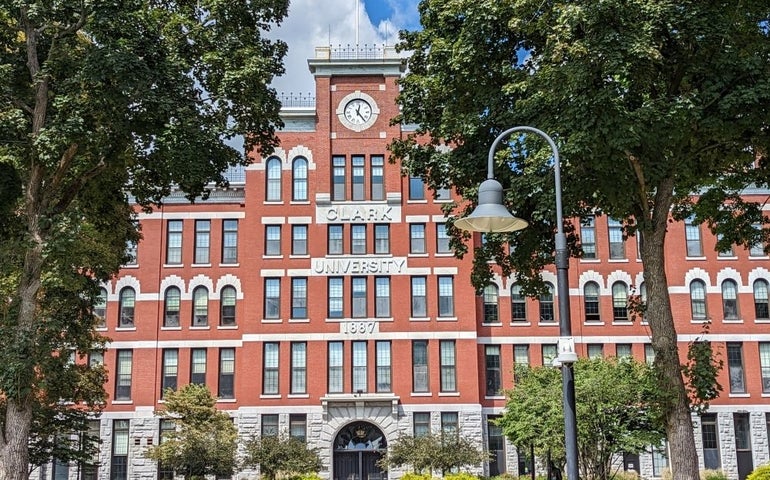In response to financial challenges and a dramatically reduced incoming freshman class, Clark University in Worcester will restructure its degree tracks and layoff up to 30% of its faculty.
For this upcoming fall, Clark’s entering undergraduate class is currently underenrolled by about 80 to 100 students, representing a nearly 20% drop from the school’s projected incoming class of 525, Clark President David Fithian told WBJ.

Additionally, the university’s graduate school enrollment is up in the air as Clark and the country as a whole are waiting to see the effects of the President Donald Trump Administration’s crackdown on immigration, greatly impacting their international student populations.
With 82% of its graduate school consisting of international students, Clark was ranked the 9th school in the nation most dependent on international students by The New York Times, higher on the list than Ivy League schools including Harvard University, Princeton University, and Brown University.
In combination with rising operational expenses, such as supplies, contracts with dining services, and wraparound services, these figures mean the university will need to significantly scale back its employee count.
“We have to contract to a right-size institution in response to fewer students, and that will quite unfortunately and regrettably mean some reduction force,” said Fithian.
Going forward, the school will reduce its staff by about 5% over the next year and reduce its faculty by about 25% to 30% over the next two years, including part-time faculty who have not been renewed. The personnel decisions will affect non-tenure track faculty, pre-tenure faculty, and adjunct faculty. It is too early to determine whether or not the layoffs will impact tenured faculty since there are a number of procedural steps needing to be addressed before those members would be affected.
This faculty contraction will slightly raise Clark’s student to faculty ratio from about 7/8:1 to about 10:1.
Furthermore, since September, the university has implemented an across-the-board hiring freeze.
“We have a commitment to our current folks as fully as we can. We’re not going to hire new folks unless people leave of their own volition from positions that we absolutely cannot keep vacant,” said Fithian.
These financial strains and reduced workforce have challenged the university to think differently about how it fulfills its mission, which will include restructuring the university’s major and minor offerings, he said.
“We have decided we need to focus on a small number of academic areas that check on our historic strengths, that are most relevant to what students are telling us they are interested in studying, what they need to be successful in the world, and with that, trying to become more efficient in delivering a high-quality education,” said Fithian.
The university does not have plans to cut any more majors or minors since closing three degree programs in April, but instead, Clark is orchestrating a reconfiguration of its different schools to promote more interdisciplinary degree tracks.
“We’re not in a critical position now, but the urgency is there, and I think the urgency is also an opportunity,” said Fithian.
Over the next few years, Clark will divide its degree tracks into three different schools:
1. The School of Climate, Environment, and Society will house its departments of sustainability and social justice; biology; and economics; the School of Geography; Center for Geospatial Analytics; and the George Perkins Marsh Institute.
2. Its second, yet-to-be-named school will house Clark’s departments of visual and performing arts; and computer science; Center for Media Arts, Computing, and Design/Becker School of Design & Technology, and the interactive media program.
3. Its third, yet-to-be-named school will house Clark’s departments of psychology; education; and biology.
The new schools will be designed to work cross-disciplinarily individually and throughout the three clusters as a whole.
“You have some faculty that will go between all of those areas depending on their field of study. So no matter where somebody sits … we’re designing our curriculum and our encouraging research that cuts across all of those,” said Fithian.
For example, the university’s current studio arts program primarily focuses on painting, sculpture, graphics, design, photography; the new model will lean more toward media arts, computing design, and the digital and interactive media.
“It doesn’t mean those other things go away. So there still will be a faculty that teaches the fundamentals of painting, but it’s not the primary thing that the majors are focused around,” said
Clark Provost John Magee.
While Clark works to make a number of structural and difficult decisions, Fithian said he wants to lead his students and faculty in as sensitive and humane a way as possible.
“This is unquestionably a moment of trying to manage a challenging budget. But that’s not all it’s about, and I think because of our size and scale and the commitment of our faculty and staff, we can take this moment as an opportunity to rethink what we do as a higher education institution and try to do that better for what we understand our students needs to be,” he said.
Mica Kanner-Mascolo is a staff writer at Worcester Business Journal, who primarily covers the healthcare and diversity, equity, and inclusion industries.

